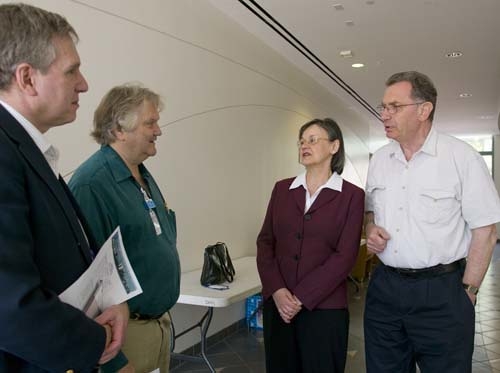Hungarian scientist-authors visit the Lab
The husband-and-wife team of Drs. István and Magdolna Hargittai visited the Laboratory last week to interview a number of people who worked closely with Edward Teller.
They are physical chemistry professors at, respectively, the Budapest University of Technology and Economics and the Hungarian Academy of Sciences and have published hundreds of technical papers and authored dozens of books on structural chemistry, symmetry, the human aspects of science, and the history of 20th century science.
Steve Libby, of the Physical and Life Sciences Directorate, hosted the Hargittais. "They are both very highly regarded in their technical fields," he noted, "and they've made a wonderful career of explaining science to broad audiences with their books on symmetry and their series of 'Candid Science' conversations with famous scientists."
"We've been in touch for about two years," said Libby, "exchanging information about Edward Teller, as I was writing a piece about Teller and István was beginning his new book about Teller."
István Hargittai is perhaps best known for his earlier book "The Martians of Science: Five Physicists Who Changed the Twentieth Century" (Oxford, 2006). This book analyzes the background and impact of five men — Eugene Wigner, Leo Szilard, John von Neumann, Theodore von Kármán and Edward Teller — who were all born in Budapest in the late 1800s to early 1900s. They remained friends and continued to work together and influence each other throughout their lives as, one by one, they migrated from Hungary first to Germany and then to the United States.
All five made key contributions to many important scientific and technical developments of the 20th century. Wigner won a Nobel Prize in theoretical physics for his research into atomic nuclei that laid the foundation for the theory of symmetries in quantum mechanics and played a crucial role in the development of nuclear reactors. Szilard was the first to propose that a chain reaction based on neutrons was possible; he initiated the Manhattan Project but later left physics and worked to control nuclear weapons. Von Neumann made major contributions to every branch of mathematics and is known as the founder of game theory and for developing the modern computer to solve complex problems.
Von Karman made key discoveries in hydrodynamics and became the first director of NASA's Jet Propulsion Laboratory, providing the scientific basis for the U.S. Air Force and space program. Teller made major contributions in physics and was the father of the (American) hydrogen bomb and co-founder of the Lawrence Livermore National Laboratory. Each was fiercely opinionated, politically active, and fought against all forms of totalitarianism.
Edward Teller has long been a figure of interest to the Hargittais, and István Hargittai is currently at work on a new book entitled "Judging Edward Teller: A Closer Look at One of the Most Influential Scientists of the Twentieth Century" (Prometheus).
As part of their research for the book, they spent two and a half days at LLNL interviewing some of the Laboratory scientists, past and present, who worked with Teller over the years, including director emeritus John Nuckolls, former director Mike May, George Chapline, Dave Dearborn, Mal Kalos, Ralph Moir, Dick More, Dick Post, Balazs Rozsnnyai, Abe Szoke and Mort Weiss. Prior to their visit to Livermore, they spent time at Stanford University's Hoover Institution, where they studied the institute's collection of Teller's papers.
While at LLNL, the Hargittais each presented a seminar. István Hargittai described his work on "reassessing" Edward Teller. "Of the five 'Martians,' I found Teller to be the closest to me personally," he observed, "but I have been puzzled by the controversial character of much of the information about him. And so I am doing a lot of additional research to create an objective image of him."
Hargittai noted that as he has delved into Teller's papers and particularly his letters, he discovered that at a human level, there were two "parallel" Tellers. "There was the seemingly arrogant and confident Teller who won every debate, the one most people thought they knew. But there was also a Teller who doubted himself and craved the friendship and admiration of his peers."
Magdolna Hargittai, an expert on the Jahn-Teller effect, gave a seminar discussing the continuing key role of Teller "effects" in chemistry. "When we talk of Teller's legacy, most people think of his physics and his politics. But he did a lot in chemistry too, mostly in a short time early in his career."
She noted that Teller's first research projects were in molecular physics-chemical physics. "His achievements in chemistry have proved to have long-lasting impact. Examples include his studies on the barrier to internal rotation, the resonance structures of benzene, the BET equation for describing multilayer absorption, and of course the Jahn-Teller effect.
At the conclusion of their visit to the Laboratory, the Hargittais expressed their appreciation to Libby and the LLNL scientists they interviewed. "We are honored to have had the chance to visit Livermore and to speak with so many scientists who knew and worked with Edward Teller. Our new book will be greatly enriched by material from Livermore and the Hoover Institution."







